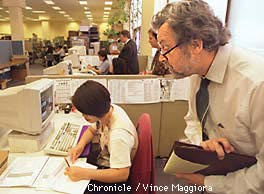
A picture from the San Francisco Chronicle’s June 20th article recording what has turned out to be the last day the public was permitted access to the records of the June 3rd election.
There were several strange things about this article from the San Francisco Chronicle.
1. The extraordinary new limits imposed by the Elections Office on the investigators’ access were not described. Investigators had to stand an “arm’s length” distance behind – and not speak to – the city employees controlling access to the records. (At the very least, explaining this would have helped readers understand the strained and hunched posture of the examiner in the photograph, Doug Comstock.)
2. The fact that placing such conditions on access to public elections records is historically unprecendented was not mentioned.
3. The reasons for the concerted effort to examine the election records were not given.
4. The eye wtiness accounts of the people examining the records and their discovery of pages and pages of suspicious signatures were not reported.
5. Doug Comstock was described as a “stadium opponent” when his long term involvement in educating the public on waste and corruption in local San Francisco government is well known. The SF Weekly gave him an award for his efforts in their annual “Best of San Francisco” issue a week after this article appeared.
6. The caption accompanying the photo claims claimed that no irregularities were found, but the article itself quoted the Director of Elections as saying that seven questionable signatures were found. Doug Comstock, not quoted in this article, has said that he is prepared to testify under oath that there were two to four pages of questionable signatures per polling place examined and the names requiring further examination were written down by Elections Department staff.
Who do you believe?
- The caption of the photo that accompanied the June 20th article:
“Stadium opponent Doug Comstock watched Erlisa Chung of the city’s elections office as she checked signatures from the June 3 election, looking for irregularities — none were found.”
- What the June 20 Chronicle article reported Director of Elections Wong said:
“Wong said that 3,200 signature checks did turn up about seven questionable voters who will be contacted to explain discrepancies between the handwriting on their voter registration forms and their signatures on rosters during the June 3 election. “
- Doug Comstock’s eye witness report:
“Newly instituted “guidelines” made viewing original registration signatures, comparing them against signatures on rosters of voters, impossible. In a parody of open-access, 12 precincts were “investigated.” Seven clerks sat before computer screens displaying four signatures simultaneously; only four observers were allowed (and they were required to stand ‘one arm’s length distance’ behind the examining clerk.)”
“Rushing pell-mell through rosters, elections staff made note of signatures that were questionable forgeries. Two to four pages of suspect signatures were documented per precinct. (Twenty to forty names each.) These were recorded on notes which were surrendered to officials.”
“These notations were obviously thrown in the waste bin, because after a few hours, Director Germaine Wong told reporters that “only six or seven questionable signatures had been found,” which merited further investigation. “
Clearly, all three versions of the story can’t be true.
Note: After this examination, access to the voter records by any means was closed to the public by order of Director of Elections Germaine Wong.



